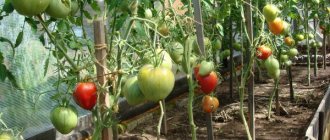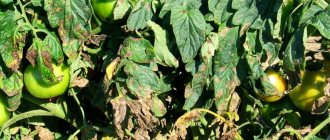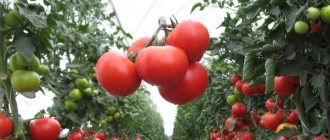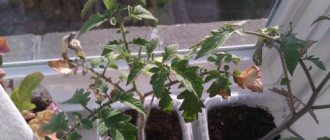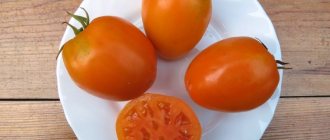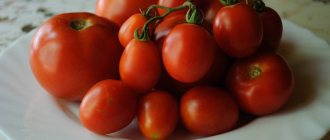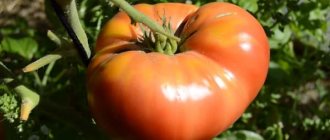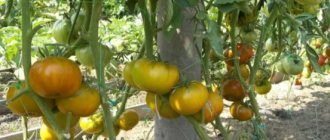- Updated: June 11, 2019
Tomatoes are annual plants that belong to the nightshade family. The fruits contain large amounts of vitamins. The composition is also marked by a richness of food acids. Not only are tomatoes delicious, they are also good for human health.
Every gardener, cultivating tomatoes on his plot, always plans to get a good harvest.
For this to really be the case, it is necessary to take care of what kind of soil will be intended for cultivating tomatoes. If the soil is too acidic, the plants will turn black and begin to hurt. Therefore, preparing the soil for the gardener is not the least important.
Correct soil composition
The key to success when growing seedlings is suitable soil. The survival rate of plants, growth rate and quality of fruits depend on it. The balanced composition of the soil mixture allows you to grow tomatoes and get a bountiful harvest.
When choosing soil, you need to pay attention to its looseness and lightness. It should absorb moisture well and be neutral in acidity level.
Why we love “golden apples”
Without tomatoes or tomatoes, as most Russians are more accustomed to calling them, today we cannot imagine our diet. At the market we choose weighty giants or miniature cherry tomatoes, painted in the usual red or other color, round or cylindrical for salads and winter preparations, not remembering that this South American plant was once an ornamental crop and its fruits were considered inedible.
By the 18th century, “golden apples” (pomo d`oro) began to appear more and more often in the diet of Europeans. In Russia they began to be eaten thanks to the famous traveler and scientist A.T. Bolotov.
Now the nutritional value of tomatoes is well studied and generally known.
These juicy, meaty vegetables are rich in vitamin C and lycopene, meaning they are a powerful antioxidant. They speed up metabolism, cleanse the body of toxins, and reduce the level of bad cholesterol. Indicated for anemia and low acidity of gastric juice. Due to their high potassium content, tomatoes have a beneficial effect on the heart and blood vessels.
Conditions for choosing a soil mixture
What kind of soil do tomatoes like? Loose nutrient mixtures and loam suit them best. If you use unsuitable soil, the seedlings simply do not sprout, so you cannot count on a harvest.
To prevent this outcome, you need to follow the basic recommendations:
- the sand in the soil should be without clay admixtures - weighting has a negative effect on the seedlings;
- Limitation in the decay stage cannot be used to fertilize seedlings under any circumstances;
- it is necessary to exclude the content of heavy metals in the mixture.
Site preparation
Before planting tomatoes, the ground must be prepared. The area for tomatoes is prepared in the fall. When preparing, follow a few rules:
- take care of good lighting of the area;
- the soil should be loose and nutritious;
- the bed cannot be placed in the same place every year;
- do not plant in place after vegetables of the nightshade family;
- It is better to plant them in beds after pumpkin vegetables, cabbage, legumes, onions, and carrots.
If you did not have time to cultivate the area in the fall, then in the spring, before placing the tomatoes in depleted soil, treat the soil with saltpeter in addition to other fertilizers. Apply fertilizers to the soil very carefully, according to the instructions.
An excess of minerals and organic matter harms plants more than their deficiency. They stop bearing fruit and increase their green mass.
Nutrient content
During the development process, plants must consume the necessary microelements in order to grow quickly, bear fruit well and not get sick.
The composition of the soil chosen for growing tomatoes must include nitrogen, potassium, magnesium and phosphorus.
The nutritional mixture also contains additional elements:
- Turf land;
- Meadow soil;
- Leaf soil;
- Sphagnum moss (to improve breathability);
- Pine needles (additional protection against pests);
- Peat (makes the soil looser).
In addition, well-rotted and sifted humus, washed clean sand without clay impurities, and perlite are added to the soil mixture.
Sometimes sawdust, scalded with boiling water, is added to the soil, but sand or peat can easily replace them.
Important! Leaf soil should not be collected under willows and oaks, because tomatoes do not tolerate the tannins it contains very well.
The importance of the right substrate
A high-quality substrate is the basis for a future rich harvest, the key to high growth energy and plant health. Using soil that is heavy or contaminated with spores of harmful fungi and larvae of pests, the gardener risks getting sick, weak, stunted seedlings. Of course, nothing worthwhile will grow from such planting material. Tomatoes are characterized by a superficial, branched, often fibrous root system. It consists of up to 70% fine suction hairs, which provides the bush with moisture and nutrition.
For people growing tomatoes from seedlings, after sowing the seeds, a good start of the plants is important. Seedlings must be strong, grow quickly, increasing the vegetative mass and root system. Moreover, it is not recommended to fertilize seedlings at the initial stage.
Young plants receive the necessary nutrition from the soil. High-quality soil for tomato seedlings is made from several components in the correct proportions.
Soil structure
It is very important that the soil has a loose structure. This is an indispensable condition for growing tomatoes. At the same time, plant roots have easy access to necessary nutrients and water, and are also supplied with sufficient oxygen.
In addition, regular soil care affects the yield. It needs to be weeded, removing the emerging weeds by the roots.
Weeds take too much moisture and nutrients from the soil. In addition, the grass shades the seedlings, and for proper development, tomatoes need to receive a lot of sunlight.
Warm bed
Anyone who wants to get their harvest early can make a warm bed for tomatoes. It has a number of advantages over conventional soil:
- the earth warms up earlier due to decomposing organic matter;
- it does not need to be dug up in the spring;
- the plant is initially provided with all useful substances.
First, a trench is dug, the depth of which is 40 cm. Thick polyethylene is placed on the sides. A layer of branches and twigs, paper, cardboard, newspapers, again bush branches, cut grass and collected leaves from the area are laid out at the bottom. A layer of soil is poured, then a layer of manure is laid out and the soil itself on which the plant will grow, its layer should be approximately 30 cm. The bed is watered with water and covered with straw or agrofibre. In the spring, when the frosts disappear, the bed quickly warms up. Therefore, tomatoes are planted in such soil earlier.
Self-preparation of soil mixture
Most gardeners prepare the soil themselves, but some prefer to purchase ready-made mixtures.
In the first case, preparation begins in the fall: soil is poured into a wooden box and left to winter outside. Frost will destroy all dangerous microorganisms, making the soil sterile. 10-14 days before sowing the seeds, the soil is brought into a warm place to warm up.
A few days before planting, they begin directly preparing the fertile mixture, adding all the necessary components.
You can use several options:
- Make a mixture of equal parts of earth, leaf soil, humus and sand, treating it with a solution of superphosphate (30 g), urea (10 g), potassium sulfate (20 g). You can sow seeds in prepared soil after 3-4 days.
- Prepare a mixture of turf soil, sand and peat, thoroughly mixing the components and adding 0.5 kg of ash and 2 tablespoons of superphosphate. After a few days, you can sow the seedlings.
- Mix humus, sand and turf soil in a ratio of 1:1:2, add 0.5 kg of ash, mix. After a few days, the mixture will be ready for sowing seeds.
Important! For sowing, you need to carefully select seeds, using only high-quality planting material.
How to calculate landing time
You can buy ready-made seedlings or grow them yourself. The first option is good provided that you are familiar with the manufacturer and are confident in the quality and varietal of the planting material. Having your own seedlings allows you not only to save money, but also to grow the required number of seedlings of the varieties and hybrids that interest you.
The time frame in which tomato seedlings need to be planted for a greenhouse or open ground depends on the time of planting it in a permanent place. Seedlings are moved into the greenhouse earlier, into the ground later, i.e., seeds of future greenhouse plants can be sown 2-3 weeks earlier than for ground plants.
When sowing is thickened, the grown seedlings are planted in individual containers
It takes about two months for seedlings to grow and become stronger. Five to seven days need to be added for seed pipping and germination. If picking is planned, it will take another week for the young plants to recover from stress.
Soil acidity
Before planting, gardeners often ask themselves: what kind of soil do tomatoes like - acidic or alkaline? This point requires separate clarification.
Ideally, the soil for growing seedlings should be slightly acidic. It is better if the pH level remains between 5.5-6.5. You can understand what acidity the soil has by using a special product that can be purchased at a flower shop.
Having discovered increased acidity, you need to take measures to correct the situation. Lime helps neutralize acidic soil. But it is necessary to add soil following certain rules.
Work on the site is carried out in the spring, before seedlings are planted. The autumn period, after harvesting, is also suitable. The area must first be cleared of debris and weeds, carefully removing them by the roots.
Next, you need to prepare (grind) a lime mixture for use and choose a good day - the work is carried out in clear weather in the absence of strong wind.
Having distributed the lime evenly over the entire territory of the site, the soil needs to be dug to a depth of about 20 cm in order to mix it well with the soil. The chemical reactions occurring during the process will neutralize the increased acidity.
When adjusting acidity, it is very important to maintain optimal soil moisture. Tomatoes do not tolerate waterlogged roots very well, so you should avoid swampy and clayey areas.
Planting in such a place will negatively affect growth and fruiting, and can also lead to the death of plants due to rotting of the roots.
In the area chosen for growing tomatoes, groundwater should not lie too close. In this case, after heavy rains, stagnation of moisture in the upper layers of the soil cannot be avoided. Elevated, well-lit areas are much better suited for planting.
However, tomatoes can suffer not only from excess, but also from lack of moisture. Therefore, watering needs to be organized regularly, carefully monitoring the condition of the soil. During periods of prolonged drought, tomatoes require watering once a day. For this you need to use only settled water.
DIY soil for seedlings
After the main work has been carried out, you need to make sure that the substrate was composed correctly and process it. Such measures include: determining the structure of the resulting soil, disinfection and acidity testing.
Mechanical composition of the soil
According to their mechanical composition, all soils are divided into:
- sandy;
- sandy loam;
- loamy;
- clayey.
The best option for growing tomatoes is sandy loam soil. It does not form a dry crust after watering, does not form stagnant water, and is quite moisture-absorbing.
In order to check whether you get a similar soil when you compose it yourself, you need to take a little of the important substrate in your hand and roll it into a sausage. Sandy loam soil cannot be rolled; it crumbles.
If you manage to get a sausage, you need to try to roll it into a ring. If the ring does not crack, then the soil is clayey; if it cracks a little, it is heavy loam; if it cracks a lot, it is medium loam; if it breaks, it is light loam.
In any case, such soil is not suitable for seedlings; you will have to prepare it again and ensure that there are no clay impurities.
Soil disinfection
Since the substrate prepared independently may contain pathogens of tomato diseases, it must be thoroughly disinfected.
You can disinfect the soil in any of three ways:
- Freezing. A sharp change in temperature kills all harmful microorganisms contained in the soil. To do this, it is exposed to the cold for several days, then brought home and allowed to thaw in a warm place. This will provoke the awakening of harmful organisms. The soil is taken outside again. For the treatment to be effective, these steps are repeated several times.
- Heat treatment. There are two disinfection options here: calcination and steaming. In the first case, the soil is heated in an oven at a temperature of 800C. Processing time – 30 min. In the second case, the soil is placed in a rag bag and steamed in a water bath for 10 minutes.
- Etching. Here disinfection is carried out using special preparations. You can use a deep pink solution of potassium permanganate or special fungicides and insecticides to shed the soil.
To prevent the soil from sticking together and becoming crumbly after processing, it is dried by spreading it on newspapers in a thin layer.
How to Test Soil Acidity
The acidity level is an important soil indicator that affects the growth of tomatoes. If the soil is acidified, or vice versa, alkalized, the seedlings develop various diseases that lead to death. For tomatoes, the soil pH level should be close to neutral and be 6.2...6.8.
You can determine the acidity level of the soil yourself at home, using a variety of methods.
Litmus paper
You can purchase this acidity measurement device at a pharmacy or gardening store. Distilled water will also be needed for measurements.
Add a handful of soil to a small amount of liquid, mix and wait 15 minutes. Then mix again and after 5 minutes you can start measuring.
Litmus paper is coated with a special reagent that changes color.
- If it turns red, orange or yellow upon contact with the resulting solution, then the soil is acidified.
- If the color changes to slightly green, the pH level is neutral.
- The bright green color of the paper indicates that the soil is alkaline.
Using the same principle, measurements can be carried out using the Alyamovsky device.
Vinegar
It is enough to pour vinegar into a small handful of soil and evaluate the reaction:
- When contacting lime, carbon dioxide is formed, so if the soil is normal, bubbles will appear.
- When conducting an experiment with an acidic substrate, there will be no reaction.
Grape juice
You need to pour grape juice into a glass and add a little earth. If the color of the liquid changes and bubbles form on the surface for a long time, then the acid-base balance is normal.
Chalk
5 tablespoons are poured into the bottle. water at room temperature, add 2 tbsp. soil and 1 tsp. crushed chalk. A fingertip is placed on top of the bottle. The air is first released from it.
- If the soil is acidic, the fingertip will straighten; if it rises slightly, the soil is slightly acidic.
- If there is no reaction, then the soil is not acidic.
Currant leaf
Several black currant leaves are plucked from the bush, poured a glass of boiling water and allowed to brew. Then a handful of earth is poured in and the color of the liquid is assessed.
If it is colored:
- in red, then the soil is acidic;
- in pink – slightly acidic;
- in blue – alkaline;
- in green – neutral.
Weeds
If soil for seedlings is taken from the site, you need to see what weeds grow nearby. On soil suitable for growing tomatoes, coltsfoot, clover, field bindweed, and nettle often grow.
The soil on which horsetail, horse sorrel, plantain, and pansies grow cannot be taken - its acidity is too high.
It cannot be said that all methods are equally accurate. Traditional testing methods (Vinegar, grape juice, chalk, currant leaf) may give inaccurate results.
How to find out soil acidity - video
Photo of ideal soil for tomatoes
Disinfection
Autumn work indoors must include soil disinfection.
To disinfect late blight, spider mites, rot and scab, use a three percent solution of copper sulfate. For the same purpose, use a solution of potassium permanganate: 5 g per 10 liters of warm water.
In the spring, the greenhouse surfaces and soil are additionally treated with Fitosporin. To prepare the solution, take 5 g of the drug per 10 liters of water. Spraying is carried out about a week before planting tomatoes.
Lighting
There are some tips regarding light.
- If the tomato seedlings are planted at the end of March, the window is on the south side, then there is enough light. All that remains is to regularly turn the container over so that the seedlings do not bend in one direction and grow evenly.
- Unfortunately, not all windows in the apartment are south-facing, or there are none at all. In addition, the climate in most of the European continent cannot boast of clear sunny days. There won’t be enough light, which is why the tomato seedlings stretch out.
Additional illumination of tomato seedlings
But additional illumination with fluorescent lamps and special lighting devices comes to the rescue. In this case, the boxes can be kept even in a pantry without windows. The duration of daylight for tomato seedlings is 11-12 hours. Fluorescent lamps are a very useful thing for proper tomato seedlings.
- Convenient to use. I installed it → turned it on and you don’t have to ask anyone to adjust the light to the window or make holes in the frames.
- Effortlessly adjusts to any height.
- Long service life (up to 50 thousand hours).
- Power from 20 W per hour (for comparison, an electric kettle consumes 500 W per hour).

